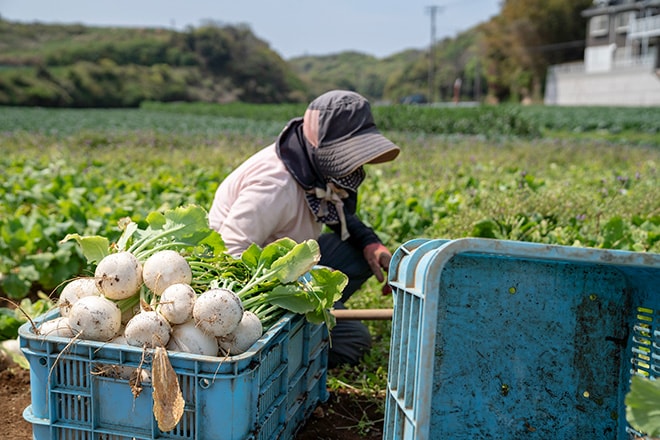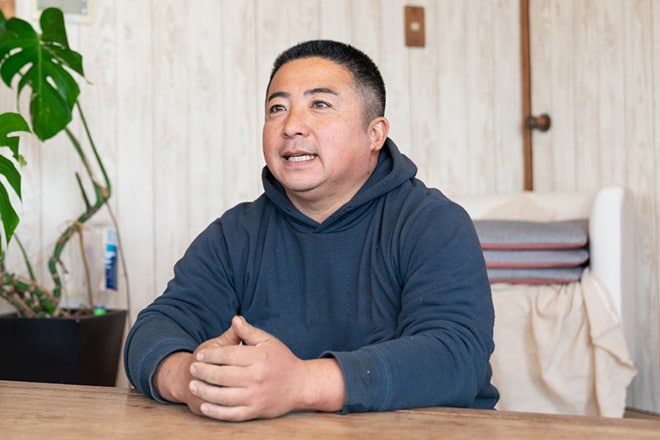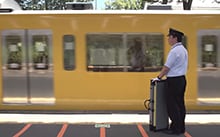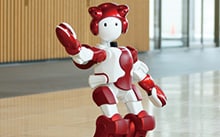Japan is facing a number of societal challenges, prominently the declining birthrate and the growing proportion of elderly people, the aging infrastructure, and child poverty. The impact of these problems in regional communities is becoming more noticeable.
In the face of such issues, the Japanese government proposed Society 5.0 in 2016, as a vision for future society to which the country should aspire. Seeking to realize a super-smart society as set out in the proposal, a movement has risen in which technologies such as big data, artificial intelligence, robotics, and autonomous driving, are applied to finding solutions to societal issues. However, none of these measures can work if the daily lives of the members of each community are taken well into consideration.
This article introduces a recent project by Hitachi’s “Future Living Lab”, an R&D activity for creating a better future by joining hands with regional communities across Japan. The project initiated with a coincidental encounter with a local farmer in the Miura Peninsula, Kanagawa Prefecture, and eventually grew into a collaborative creation to solve the area’s local issues to create a sustainable community.

Turnip farms in Miura, Kanagawa Prefecture
The man who planted the seed to start the project is Mr. Dai Fujiwara, a creative director known for his "color hunting" technique of extracting color from living things, nature, and other aspects of our environment, and using them in design creation. Mr. Fujiwara was working on a theme of social and regional-economic sustainability, when a collaborative creation with Hitachi’s Research & Development Group has begun in March 2018.
As a first step, a survey was conducted to research regional issues in Japan. The targeted survey area were Miura Peninsula and the Shonan area, domains where Mr. Fujiwara has previously engaged in projects such as redesigning of railway cars of the Enoshima Electric Railway which runs from Fujisawa to Kamakura. One sunny autumn day in 2018, members from Mr. Fujiwara’s team and Hitachi’s Future Living Lab gathered to conduct a fieldwork of the local community. Mr. Fujiwara knew that the area was home to several vibrant local vegetable markets, but he did not know anybody there. According to Maiko Kaneda, a designer of Hitachi Vision Design Project: "He would just drop by these markets, say hello, and buy vegetables. This is how we eventually met Mr. Ishii."
Among the several direct-sales shops they visited, they came across a shop with eye-catching graphical signs and creative explanations of the products, which particularly represented a strong passion of the farmers and sellers for their products. This shop, which sold Miura turnips and other seasonal vegetables, was represented by Mr. Ishii.
Mr. Ishii has resided in Miura since he got married and took over his wife’s family business. Before long, however, he began to notice a problem faced by the farmers of local Miura. "Miura is famous for growing Japanese white radishes. But they are one of the heaviest vegetables out there, and they have to be pulled from the ground and then carried, which is quite hard work. Even worse, for all the labor hours spent on them, they do not turn much into profit."
"I think about things from the standpoint of what's going to happen in 5 or 10 years from now," he states. "If I keep growing white radishes for 10 years until I turn 50, will I be able to still grow these heavy radishes and ship them off? That could be a problem, you know?" Adding to this is that most farms in Miura and the rest of Kanagawa Prefecture are family-run, and it will certainly be even more difficult than now to find labor. After some hard thinking, Mr. Ishii decided to grow turnips instead. Turnips only takes half the time to harvest compared to white radish, and its size is relatively small and easy to handle, while they can be sold at a higher price. Mr. Ishii made this big decision six years ago.

Mr. Ryo Ishii, representative for PEEKABOO
Since then, Mr. Ishii's turnip farming business has made steady progress, and he began thinking about other farmers and the Miura region. At local farmer gatherings, he often hears farmers lamenting about how difficult it is for them to make enough profit. In addition, young people are moving to the urban area, and the farming population is decreasing. If this continues, both farming and the Miura region itself will face a dismal future. Even with its high potential, selling turnip still requires much work to harvest.
What Mr. Ishii first came to realize was that "only a farmer that is a professional can grow vegetables that are high quality " and that "it is because a professional vegetable farmer does everything from harvest to sales that the market is convinced by its value." On the other hand, this also meant that the farmers do not have to mind about the work they are not good at, such as washing the harvested vegetables and visiting supermarkets at the marketing stage. Mr. Ishii says: "This is why I requested farmers to fully demonstrate their professional skills, while providing them with the know-how that my farm acquired through trial and error, everything from applying fertilizer and pesticides to planting, and ultimately asking them to produce their crop in the same way. By taking over and consolidating everything after harvesting, we are able to avoid degrading the value of the vegetables with appropriate washing and boxing. As a result, each farmer is able to clear a profit as well as reliably deliver fresh vegetables to consumers, and, I thought, in this way we could contribute to the region."

Washing Miura turnips
As they listened to Mr. Ishii talk, the members of the Future Living Lab felt that Mr. Ishii’s initiative links with Hitachi’s vision of conceiving the future based on careful considerations of an ideal industry-community relationship. Maiko Kaneda of Hitachi’s R&D Group started to feel that "with someone like Mr. Ishii, a producer who truly cares about the region, I wondered if we could find the best form for new relationships between the region, its people, and the local industry."
After this first meeting, Mr. Ishii, the people of Miura, and Hitachi continued conversations on various topics, and two important points came up.
The first was the importance of creating a vision of the community and inspiring the children, who leads the future of the region. Farmers normally work non-stop from early in the morning, and with age comes the additional problem of who will take over. Even though children can understand the importance of farming, the value of food, symbiosis with nature, and other aspects of agriculture, they may feel that "it is a tough life that they do not want for themselves, and that they do not want to stay in the region. Therefore, keeping them from thinking this way by showing them the fun and exciting aspects of their region will help Miura,” Kaneda says. Miura’s regional issue will likely to be a common issue in the near future all across Japan.

Mr. Ishii, Mr. Fujiwara, and Hitachi having a conversation at the table
The second point that came out of the conversations was that it is probably easier to grasp the challenge that Miura is facing for those who moved to Miura from other areas, like Mr. Ishii, and Miura natives who recently returned to the region.
Project members also found out through Mr. Ishii that "Many of those who moved to Miura tend to think that the locals will not let you into their circle or extend invitations to you and treat you like an outsider." That was when Ms. Kaneda and the other project members were just about convinced that, as an outsider themselves, there is definitely something that Hitachi can do for this community.
Takashi Shirasawa,Senior Designer of the Vision Design Project, says "In order to connect various things, a local key person with passion, like Mr. Ishii, is crucial." In this way, day after day, conversations continued between Mr. Ishii and other Miura residents on how to implement the future vision created by Hitachi in their neighborhood.
In the end, the project team concluded that the core message of the new vision should be centered on how much love the farmers have for their community and the vegetables. After that, there were countless dialect between Hitachi and Mr. Ishii to give their ideas into shape.

Meetup for conversation with people of the region
After that, Mr. Fujiwara's creative team and Hitachi focused on understanding and digesting Mr. Ishii's ideas and expressing them as “art”. Rather than presenting a straightforward, easy-to-understand answer, they chose art as a means of communication with the hope to rouse various emotions and ideas from local residents and encourage them to participate in the discussions.
As the project team’s final output, an unmanned payment stand was developed inside Mr. Ishii’s shop. This stand uses Hitachi’s digital technology that supports dynamic pricing. First, customers can enter the price of the vegetables they want to purchase. Then, dozens of messages written in word balloons, such as "they look delicious," "this is our first visit to Miura," or "we want to support Miura," are lined up next to the interactive payment stand. By selecting three messages and placing them onto the stand, the vegetable price instantly changes by just a small amount.
For example, when a customer places the message "When was this vegetable picked?" the screen displays the message: "We are working hard to stock vegetables picked this morning." This is then followed by the message: "We'll give you 8 yen off," and the customer is given a discount. If the customer places the message "We used to live in Miura," then another message unfolds on the screen and says: "Well, in that case can we get your support?" and adds 10 yen to the initial price. Though it is an unmanned, this payment stand enable the consumers to exchange their comments with the voice of farmers, and create opportunities for regional internal communication.

Interactive payment stand installed at an unmanned direct-sales stand
Mr. Ishii's vegetable shop is a log house built with wood which were used in the temporary housing erected in Fukushima Prefecture after the Great East Japan Earthquake. Although the structure was simple enough to be constructed in half a day, Mr. Ishii wanted to build it communally, so he gathered people together and assembled it as an all-day event.
With respect to things like the interactive payment stand and community events like this, Mr. Ishii says "I felt that it is possible to accelerate regional revitalization by partnering with Hitachi for not only its technology, but also its creative collaboration approach and external communication abilities."

Assembling the log house direct-sales stand
Looking forward, Mr. Ishii's and Hitachi is eager to find more solutions to the community’s issues in the Miura region, and to spread such culture to take action for the local community.
The logistics that support the region, for example, have a big problem. The falling birthrate and rising elderly population are also manifesting in the logistics industry as a shortage of drivers. Mr. Ishii expounds on this: "A friend of mine who is the president of a logistics company told me that because of the labor shortage, he sometimes has to drive a truck himself. He’s also concerned that if he's out of the office doing actual work, the company will stall, so of course I understand how serious this problem is for him. Currently, outgoing trucks are loaded with cargo but they come back empty. I just wonder if getting Hitachi's support with their technologies and systems, such as AI and cross-industry networks, would allow truck operation with full loads both ways. Since this would be eco-friendly and would directly impact cost, speaking for my own business, consumers would be able to buy vegetables at a lower cost and producers would see their profits restored. I'd be really happy to see such a cycle come about."
He goes on to say that "I’ve talked about this idea to my friends in the region, but they just responded 'that kind of thing's not possible' and put an end to it." But, he continues: "As I work with Hitachi, I get the feeling that this will somehow all work out and realize my ideas. I think it's very important to be able to think this way."
" It doesn't have to be only about vegetable shops. I just wonder if a system can be created which will connect other places in Miura with each other and enable them to access each other's information, in this way getting people to actively move inside in Miura," says Mr. Ishii. As he talks about his ideas for the revitalization of the entire region of Miura, there is no end to his dreams.
When opportunity is provided, people gather, minds meet, conversation goes back and forth, and seeds of innovation will come out of it. Seeking out collaborative creation between industry and regions, Hitachi saw its accumulated knowledge result in the project with Mr. Ishii and Miura. As a starting point for new opportunities that can revitalize the region, a sprout aimed at future urban development has just begun to emerge.

Left: Takashi Shirasawa, Vision Design Project Senior Designer, Hitachi, Ltd.
Center: Ryo Ishii, PEEKABOO
Right: Maiko Kaneda, Vision Design Project Designer, Hitachi, Ltd.
Photograph: Daisuke Yoshinari







